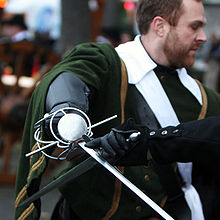Parrying dagger

The Gauche (also fencing dagger , Linkand , left hand , left-handed dagger , Left Hand Dagger , French "Main gauche") refers to a guided mostly with the left hand edged weapon that was used to parry and block the blade of the enemy to those with their own Rapier make can.
The rapier emerged as a civil weapon in Spain at the end of the 15th century and spread throughout Europe at the beginning of the 16th century. The weapon was designed against opponents without armor; fast attacks could be carried out, which in turn could be parried with the rapier itself. Nevertheless, southern European fencing schools in the 16th century provided additional parrying options. This is how the Italian fencing master Achille Marozzo describes defensive possibilities with shield , cloak and dagger wrapped around the forearm in 1536 . The rapier in the right hand became a failure , the dagger in the left hand a paradeguided. Of course, an attack could also be launched with the dagger. This led to the specialization of the dagger into an independent type, the parrying dagger. In many cases, the rapier and the parrying dagger were made as a pair in the same style.
Types
Ordinary parrying dagger
The daggers usually consist of a short (about 25 cm), strong, narrow blade with a sharp point, a short handle and a long quillons . This is either straight, S-shaped (bent up on one side, bent on the other) or bent downwards on both sides (i.e. towards the tip). They often have a parrying ring. While straight crossguards serve to intercept and deflect the opponent's blade, the downwardly curved crossguards allow the opponent's blade to be clamped by rotating the dagger. In order to increase the efficiency of the parrying dagger, various blade catchers were developed, which led to the jumping blade dagger and the rapier breaker.
With the advent of the cavalier sword, the parrying daggers disappeared in the 1630s. The exceptions were Spain and southern Italy. There the characteristic Spanish parrying dagger later developed from it.
Parrying daggers were sometimes called "sword breakers" or "bladebreakers", but only rarely did they succeed in breaking an opponent's blade.
Jumping blade dagger
With this version of the parrying dagger, a lock is released at the push of a button , so that two steel springs push the side pieces of the three-part blade apart; the opposing blade is caught in it. The lateral divergence was limited by the crescent-shaped curved shape of the crossguards.
Sword breaker
There are deep incisions in the powerful blade to grip the opponent's blade. Some variants also have spring-loaded locking hooks.
Spanish parrying dagger
The Spanish parrying dagger appeared in the middle of the 17th century in Spain and in areas belonging to the Spanish Crown in southern Italy ( Kingdom of the Two Sicilies ) and was used until the 18th century. The dagger has a triangular, outwardly curved hand guard tapering to the pommel. The daggers often have blade catchers running parallel to the blade from the handguard.
literature
- Heinz Werner Lewerken: Combination weapons of the 15th – 19th centuries Century. Military Publishing House of the German Democratic Republic , 1989, ISBN 3327005168 , pages 125–126
- Wendelin Boeheim : Handbook of the armory. original 1890, pages 299–301 [1]
- Ewart Oakeshott : European Weapons and Armor. 1980
Web links
Individual evidence
- ↑ Oakeshott, 1980, p. 136
- ↑ Lewerken, 1989, p 125
- ↑ Oakeshott, 1980, p. 230
- ↑ Boeheim, 1890, p. 300
- ↑ Lewerken, 1989, p 125
- ↑ Oakeshott, 1980, p. 229
- ↑ Lewerken, 1989, p 125
- ↑ Oakeshott, 1980, p. 229
- ↑ Lewerken, 1989, pp. 125-126
- ↑ Lewerken, 1989, p 126
- ↑ Oakeshott, 1980, p. 229
- ↑ Lewerken, 1989, p 126





